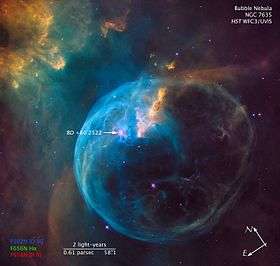BD+60 2522
 NGC 7635 surrounding BD+60 2522 Credit: NASA, ESA, and the Hubble Heritage Team (STScI/AURA) | |
| Observation data Epoch J2000 Equinox J2000 | |
|---|---|
| Constellation | Cassiopeia |
| Right ascension | 23h 20m 44.5203s[1] |
| Declination | +61° 11′ 40.561″[1] |
| Apparent magnitude (V) | 8.67[2] |
| Characteristics | |
| Spectral type | O6.5(f)(n)p[3] |
| U−B color index | −0.62[2] |
| B−V color index | +0.41[2] |
| Astrometry | |
| Radial velocity (Rv) | −26[4] km/s |
| Proper motion (μ) | RA: 3.10[1] mas/yr Dec.: 4.60[1] mas/yr |
| Parallax (π) | 13.0 ± 8.0[5] mas |
| Distance | 2,400[6] pc |
| Absolute magnitude (MV) | −5.5[6] |
| Details[7] | |
| Mass | 44 M☉ |
| Radius | 15 R☉ |
| Luminosity | 398,000 L☉ |
| Temperature | 37,500 K |
| Rotational velocity (v sin i) | 178 - 240 km/s |
| Age | 2[8] Myr |
| Other designations | |
| Database references | |
| SIMBAD | data |
BD+60°2522 is a bright O-class star that has produced the Bubble Nebula (NGC 7635) with its stellar wind. The exact classification of the star is uncertain, with a number of spectral peculiarities and inconsistencies between the appearance of the star itself and the effects on the nearby nebulosity, but it is undoubtedly a highly luminous hot massive star.[6] Direct spectroscopy yields a spectral class of O6.5 and an effective temperature around 37,500K. It is a member of the Cassiopeia OB2 stellar association in the Perseus Arm[8] of the galaxy at about 8,500 light years distance.[9]
Although BD+60°2522 is around two million years old, the surrounding nebula is apparently only about 40,000 years old. The bubble is expected to be formed as a shock front where the stellar wind meets interstellar material at supersonic speeds. The wind from BD+60°2522 is travelling outwards at 1,800 - 2,500 km/s, causing the star to lose over a millionth of the mass of the sun every year.[8]
References
- 1 2 3 4 Hog, E.; Kuzmin, A.; Bastian, U.; Fabricius, C.; Kuimov, K.; Lindegren, L.; Makarov, V. V.; Roeser, S. (1998). "The TYCHO Reference Catalogue". Astronomy and Astrophysics. 335: L65. Bibcode:1998A&A...335L..65H.
- 1 2 3 Ducati, J. R. (2002). "VizieR Online Data Catalog: Catalogue of Stellar Photometry in Johnson's 11-color system". CDS/ADC Collection of Electronic Catalogues. 2237. Bibcode:2002yCat.2237....0D.
- ↑ Walborn, Nolan R.; Howarth, Ian D.; Evans, Christopher J.; Crowther, Paul A.; Moffat, Anthony F. J.; St-Louis, Nicole; Fariña, Cecilia; Bosch, Guillermo L.; Morrell, Nidia I.; Barbá, Rodolfo H.; Van Loon, Jacco Th. (2010). "The Onfp Class in the Magellanic Clouds". The Astronomical Journal. 139 (3): 1283. arXiv:1001.4032
 . Bibcode:2010AJ....139.1283W. doi:10.1088/0004-6256/139/3/1283.
. Bibcode:2010AJ....139.1283W. doi:10.1088/0004-6256/139/3/1283. - ↑ Wilson, Ralph Elmer (1953). General Catalogue of Stellar Radial Velocities. Carnegie Institution of Washington. Bibcode:1953GCRV..C......0W. LCCN 54001336.
- ↑ Jenkins, Louise F. (1952). General Catalogue of Trigonometric Stellar Parallaxes. Yale University Observatory. Bibcode:1952GCTP..C......0J. LCCN 53001043.
- 1 2 3 Moore, B. D.; Walter, D. K.; Hester, J. J.; Scowen, P. A.; Dufour, R. J.; Buckalew, B. A. (2002). "Hubble Space Telescope Observations of the Windblown Nebula NGC 7635". The Astronomical Journal. 124 (6): 3313. Bibcode:2002AJ....124.3313M. doi:10.1086/344596.
- ↑ Rauw, G.; De Becker, M.; Vreux, J. -M. (2003). "Line profile variability in the spectra of Oef stars". Astronomy and Astrophysics. 399: 287. Bibcode:2003A&A...399..287R. doi:10.1051/0004-6361:20021776.
- 1 2 3 Anand, M. Y.; Kagali, B. A.; Murthy, Jayant (2009). "Study of Bubble nebula using IUE high resolution spectra". Bulletin of the Astronomical Society of India. 37: 1. arXiv:0903.2828
 . Bibcode:2009BASI...37....1A.
. Bibcode:2009BASI...37....1A. - ↑ Mason, Brian D.; Hartkopf, William I.; Gies, Douglas R.; Henry, Todd J.; Helsel, John W. (2009). "The High Angular Resolution Multiplicity of Massive Stars". The Astronomical Journal. 137 (2): 3358. Bibcode:2009AJ....137.3358M. doi:10.1088/0004-6256/137/2/3358.